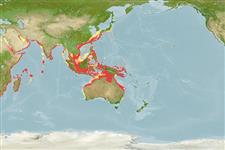Preferred temperature (Ref.
115969): 23.8 - 29, mean 27.9 (based on 2110 cells).
Fylogenetische diversiteitsindex (Ref.
82804): PD
50 = 1.0039 [Uniqueness, from 0.5 = low to 2.0 = high].
Bayesian length-weight: a=0.00363 (0.00147 - 0.00899), b=3.07 (2.86 - 3.28), in cm Total Length, based on LWR estimates for this (Sub)family-body shape (Ref.
93245).
Trofisch niveau (Ref.
69278): 4.3 ±0.3 se; based on diet studies.
Weerstandsvermogen (Ref.
120179): Zeer laag, minimale populatieverdubbelingstijd meer dan 14 jaar (Fec=2).
Fishing Vulnerability (Ref.
59153): Very high vulnerability (90 of 100).
